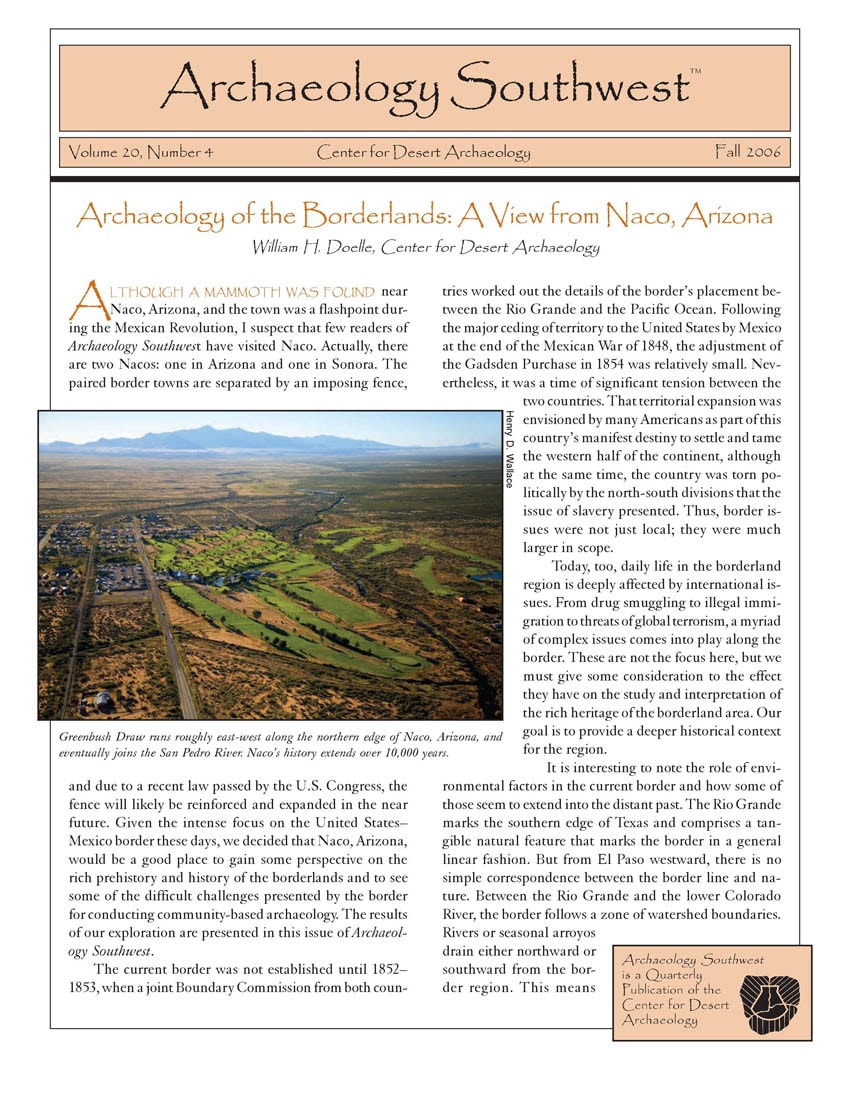Archaeology of the Borderlands: A View from Naco, Arizona

Greenbush Draw runs roughly east-west along the northern edge of Naco, Arizona, and eventually joins the San Pedro River. Naco’s history extends over 10,000 years.
Archaeology Southwest Magazine Vol. 20, No. 4
FREE PDF DOWNLOAD
Issue editor: William H. Doelle, Archaeology Southwest (formerly the Center for Desert Archaeology)
Although a mammoth was found near Naco, Arizona, and the town was a flashpoint during the Mexico Revolution, I suspect that few readers of Archaeology Southwest Magazine have visited Naco. Actually, there are two Nacos: one in Arizona and one in Sonora. The paired border towns are separated by an imposing fence, and due to a recent law passed by the U.S. Congress, the fence will likely be reinforced and expanded in the near future. Given the intense focus on the United States–Mexico border these days, we decided that Naco, Arizona, would be a good place to gain some perspective on the rich prehistory and history of the borderlands and to see some of the difficult challenges presented by the border for conducting community-based archaeology. The results of our exploration are presented in this issue of Archaeology Southwest Magazine.
The current border was not established until 1852–1853, when a joint Boundary Commission from both countries worked out the details of the border’s placement between the Rio Grande and the Pacific Ocean. Following the major ceding of territory to the United States by Mexico at the end of the Mexican Ware of 1848, the adjustment of the Gadsden Purchase in 1854 was relatively small. Nevertheless, it was a time of significant tension between the two countries. That territorial expansion was envisioned by many Americans as part of this country’s manifest destiny to settle and tame the western half of the continent, although at the same time, the country was torn politically by the north–south divisions that the issue of slavery presented. Thus, border issues were not just local; they were much larger in scope.
Today, too, daily life in the borderland region is deeply affected by international issues. From drug smuggling to illegal immigration to threats of global terrorism, a myriad of complex issues comes into play along the border. These are not the focus here, but we must give some consideration to the effect they have on the study and interpretation of the rich heritage of the borderland area. Our goal is to provide a deeper historical context for the region.
Articles include:
Archaeology of the Borderlands: A View from Naco, Arizona — William H. Doelle, Center for Desert Archaeology
The Border Town of Naco — J. Homer Thiel, Desert Archaeology, Inc.
The United States Military and the Border — Tobi Taylor, Center for Desert Archaeology, and Debby Swartzwelder, University of Arizona South
Buffalo Soldiers at Fort Huachuca — Patricia Cook, Desert Archaeology, Inc.
Camp Naco — Debby Swartzwelder, University of Arizona South
The Two Terrenates — J. Homer Thiel, Desert Archaeology, Inc.
Paleoindian Research in the Borderlands — Vance Holliday, University of Arizona
Reflections on Surveying the Borderlands Region of Northern Sonora — Ned Gaines, Northern Land Use Research, Inc.
The Naco Cemeteries and Cochise County Zoning Regulations — John Madsen, Arizona State Museum
Documenting Arizona’s Historic Cemeteries — Jacquie Dale, Center for Desert Archaeology
Trinidad Lopez and the Naco Cemetery — Tobi Lopez Taylor, Center for Desert Archaeology
Connecting to Community History: A Personal View — Rebecca Orozco, Center for Southwest Studies, Cochise College
Rediscovering Camp Naco — Debby Swartzwelder, University of Arizona South
Naco’s Historical Diversity — William H. Doelle, Center for Desert Archaeology
Back Sight — William H. Doelle, Center for Desert Archaeology
Subscribe

